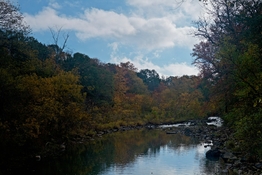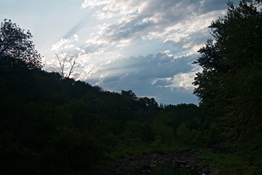OK, so given the following:
* Your camera is limited to a (heavily) center-weighted metering program
* The scene is a 'typical' landscape with a foreground of trees and a bright sky (mostly blue, maybe wisps of clouds)
* The horizon in your composition is between 1/3 and 2/3 from the bottom (or top) edge of the frame
(I'm specifically thinking of the kind of images I've seen you post so far):
I would do the following: dial in +2 stops, point camera at sky so the sky fills the viewfinder, take meter reading and lock the reading, then recompose for the desired composition.
This will ensure that the bright sky will be at +2, which with a little bit of luck won't blow out anything unless there are some really bright spots (e.g. a cloud with a sunlit edge). Note that locking the meter reading while pointing the camera at the sky is crucial. If you dial in +2 and point the camera so that the horizon is halfway the frame, you're toast. Same camera settings, only one difference in the way of working...hence why I kept pressing on details. It makes a difference.
Frankly, and this is by no means intended to take a p**s on Leica, but I find the combination of a digital sensor (inherent risk of blown out highlights), center-weighted metering system (uncertainty as to what you're actually measuring and the risk of specular highlights messing up your readings) and no display to verify results (depriving you of a short feedback loop for effective learning) a very unfortunate combination especially for someone who is in the process of learning the basics of exposure. I would very strongly recommend picking up a (cheap) digital camera with a display to practice exposure with. Once you've figured out how that works, it'll be much easier to translate your approach and preferences to the MD262. This learner-camera can be of any type (although I wouldn't opt for a smartphone for this purpose) - mirrorless, SLR, compact.











 …
…
